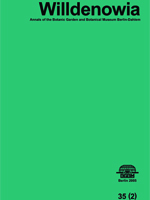Two new species of Xanthosoma sect. Acontias, X. mariae and X. latestigmatum, are described and illustrated. They have pilose, pedate leaf blades as have in Xanthosoma only X. plowmanii and X. pottii, and their pollen grains are released as monads, unlike in all other Xanthosoma species, which, as far as studied, release the pollen in tetrads. X. mariae is an evergreen plant mainly distinguished by its dark green velvety lustrous leaf blades with numerous leaflets and tuber-like swellings at the junction of petiole and blade; the gynoecium is of the Acontias type and the ovary is pilose in the lower part. X. latestigmatum is seasonally dormant and has medium green leaf blades with numerous leaflets and no tuber-like swellings; the gynoecium is of the Caladium type (with a very broad stigma) and completely glabrous. The relationship of the genera Caladium and Xanthosoma is discussed, C. paradoxum is transferred to Xanthosoma and the new combination X. paradoxum validated, and a key to the genera of the tribe Caladieae given.
How to translate text using browser tools
23 December 2005
Two new species of Xanthosoma (Araceae) from South America and notes on the tribe Caladieae
Josef Bogner,
Eduardo G. Gonçalves
J. Bogner
1986: A new Xanthosoma species from Pará, Brazil. — Aroideana 8: 112–117. Google Scholar
J. Bogner
&
D. H. Nicolson
1991: A revised classification of Araceae with dichotomous keys. — Willdenowia 21: 35–50. Google Scholar
T. B. Croat
&
J. Bogner
2005: Xanthosoma feuersteiniae (Araceae), a new species from southeastern Ecuador. —
Willdenowia
35: 327–331. [
CrossRef
] Google Scholar
A. Engler
1920: Araceae-Colocasioideae. — In:
A. Engler
(ed.), Das Pflanzenreich 71. — Leipzig. Google Scholar
G. Erdtman
1945: Pollen morphology and plant taxonomy V. On the occurrence of tetrads and dyads. — Svensk Bot. Tidskr. 39: 286–297. Google Scholar
E. G. Gonçalves
1999: A new pedate-leaved species of Xanthosoma Schott (Araceae: tribe Caladieae) with linear leaflets, from the Brazilian Pantanal. — Aroideana 22: 3–6. Google Scholar
E. G. Gonçalves
,
P. S. A. Diener
,
C. Sousa
,
G. de Alarcao
&
G. O. Pina
2004: A preliminary survey of gynoecium morphology in Xanthosoma (Araceae). — Aroideana 27: 182–189. Google Scholar
M. H. Grayum
1984: Palynology and phylogeny of the Araceae. — PhD Dissertation, University of Massachusetts (Amherst). Google Scholar
M. H. Grayum
1992: Comparative external pollen ultrastructure of the Araceae and putatively related taxa. — Monogr. Syst. Bot. Missouri Bot. Gard. 43: 1–167. Google Scholar
W. L. A. Hetterscheid
&
R. W. J. M. van der Ham
2001: Notes on the genus Amorphophallus (Araceae) 11: New and obsolete species from East Malaysia and continental Southeast Asia. — Blumea 46: 253–282. Google Scholar
M. Madison
1981: Notes on Caladium (Araceae) and its allies. — Selbyana 5: 342–377. Google Scholar
S. J. Mayo
&
J. Bogner
1988: A new species of Caladium (Araceae) with notes on generic delimitation in the Colocasioideae-Caladieae. — Willdenowia 18: 231–242. Google Scholar





